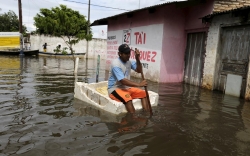












Floods, fires, snowstorms and tornadoes push Earth’s extremes as New Year approaches
Rain-swollen rivers across Missouri were still rising on Wednesday, with widespread flooding forcing the evacuation of hundreds of people, closing part of a major interstate highway and threatening to wash out scores of structures.
Several major rivers and tributaries in Missouri and Illinois were poised to crest at record levels, the National Weather Service said. Some of the rivers are expected to continue to rise until Saturday.
Federal officials, meanwhile, continue to monitor 19 vulnerable levees on the rising Mississippi River and its tributaries, warning that hundreds of homes in the two states could be threatened by a rare winter flood.
The Meramec River near St. Louis is expected to climb more than 3 feet above the previous record by late this week. At least 20 deaths over several days in Missouri and Illinois were blamed on flooding, mostly involving vehicles that drove onto swamped roadways.
“It's very clear that Missouri is in the midst of a very historic and dangerous flooding event,” Missouri Gov. Jay Nixon said during a Tuesday news conference.
On Tuesday, the Mississippi River spilled over the top of a levee at West Alton, Missouri, a town of approximately 520 people about 20 miles north of St. Louis. Mayor William Richter ordered any residents who had not already evacuated to get out of harm's way.
Across the river in Alton, Illinois, dozens of volunteers helped place sandbags where water is expected to rise. Mayor Brant Walker said in a statement that “even with our best efforts of sandbagging and pumping,” flooding was expected at least in the basements of the downtown business district.
In Union, another eastern Missouri town, water from the normally docile Bourbeuse River reached the roofs of a McDonald's, a QuikTrip and several other businesses. The river reached an all-time high Tuesday, nearly 20 feet above flood stage.
Interstate 44 was closed near the central Missouri town of Rolla, and a 10-mile section of Interstate 70 was shut down in southern Illinois before it was reopened late Tuesday afternoon. Hundreds of smaller roads and highways were also closed in the two states, and flood warnings were in effect.
Nixon activated the National Guard to assist with security in evacuated areas and to help keep road closure sites clear.
In southern Illinois, the Department of Corrections transferred an unspecified number of inmates from a state prison to other locations because of flooding risks. The facility has nearly 3,700 inmates.
The Mississippi River is expected to reach nearly 15 feet above flood stage on Thursday at St. Louis, which would be the second-worst flood on record, behind only the devastating 1993 flood.
Alderman Larry Arnowitz said up to 500 homes could be threatened if the River des Peres — a man-made storm and sewage channel that flows through southern St. Louis into the Mississippi River — rises much more than projected. But he was confident that with no rain in the forecast for the next several days and with the help of thousands of sandbags, everything would be OK.
The high water was blamed on the shutdown of a wastewater treatment plant on Monday just south of St. Louis, causing sewage to go directly into nearby rivers and streams. The Metropolitan Sewer District of St. Louis said the Fenton wastewater treatment plant, which is designed for 6.75 million gallons per day of flow, was treating nearly 24 million gallons per day at the time of the malfunction.
One of the two wastewater plants in Springfield, Missouri, also failed, allowing partially treated sewage to flow into a river.
The U.S. Coast Guard closed a 5-mile portion of the Mississippi River near St. Louis because of flooding. Capt. Martin Malloy cited high water levels and fast currents in the river, which is a vital transportation hub for barges that carry agricultural products and other goods.
In central and southern Illinois, major flooding was occurring along the Kankakee, Illinois, Sangamon and Vermilion rivers.
In Granite City, Illinois, about 30 residents of a flooded trailer park idled in a Red Cross emergency shelter in a church basement. The park's property manager told Shirley Clark, 56, and other displaced residents that it could be another 10 to 12 days before they would be able to return to their homes.
“We need help over here,” said Clark, a diabetic who said she left behind her insulin supply. “We're just holding on.”
Wire services
Error
Sorry, your comment was not saved due to a technical problem. Please try again later or using a different browser.